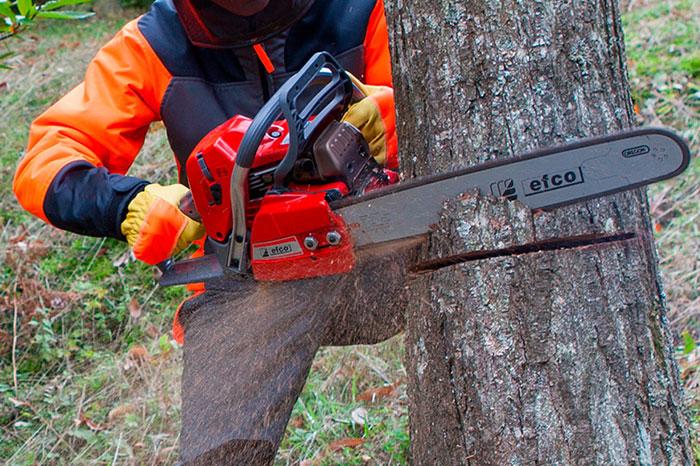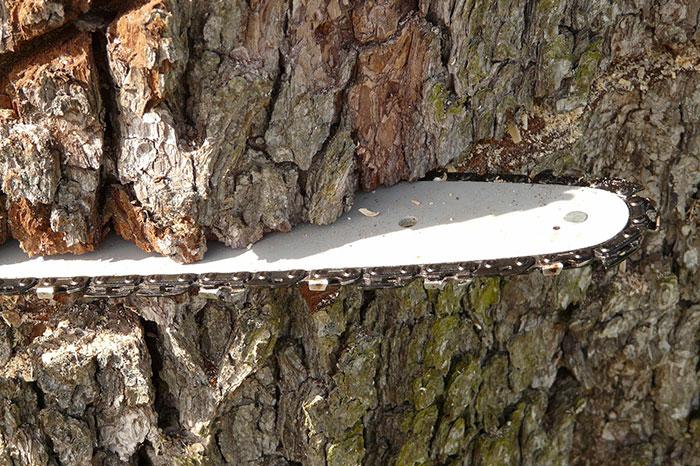Guide to chainsaw guide bars

Are you thinking of buying a chainsaw, or have you already chosen a model that suits your needs? If so, now is the time to further familiarise yourself with this tool, which is extremely useful for small and large gardening jobs, DIY tasks and for cutting firewood.
A chainsaw comprises three main parts: the engine unit, cutting system and handles. In this article we focus on the cutting system, which consists of the guide bar and saw chain. In particular, we examine the guide bar, whereas the next edition of the blog will deal more closely with the saw chain.
Components of a chainsaw guide bar
As you may already know, the chainsaw guide bar (also called the chainsaw blade) has the vital job of guiding the movement of the chain, which is the machine’s cutting element.
What does a guide bar consist of?
It depends on the model. For example, a carving bar differs slightly from a standard guide bar. Nevertheless, all types share similar characteristics, such as:
- Tail: this is the part of the guide bar that fits inside the body of the chainsaw.
- Mounting slot: a shaped hole that connects the guide bar to the machine by means of large screws with threaded ends (studs).
- Adjuster hole: this houses the pawl needed to adjust the chain tension.
- Oil reservoir outlet hole: essential for proper lubrication of the guide bar/chain assembly.
- Bar rails: these enclose the groove along the edge of the guide bar.
- Groove (or track): the channel between the rails along which the chain runs.
- Tip (or nose): this can be reinforced or fitted with a nose sprocket.
- Nose sprocket: this can be fixed or replaceable and is a kind of gear wheel that improves the movement of the chain around the bar, reduces friction and helps to tension the chain.
How do I measure the guide bar of my chainsaw? Where do I measure it from?
The actual length of the chainsaw blade, i.e. the tail-tip distance, is not the best criterion for evaluating a guide bar. Instead you should take into account the cutting length, which is the guide bar’s useful length, i.e. the amount of the bar sticking out of the body of the saw.
It is the guide bar’s cutting length, in addition to the chainsaw’s power rating, that give you an idea of what the machine can do: from simple pruning to cutting through thick tree trunks. As you can see in the Efco catalogue, guide bars for pruning chainsaws and pruners have shorter cutting lengths (25-30 cm) compared with standard bars and carving bars. Standard guide bars have a cutting length ranging from 35 to 76 cm.
Compact chainsaws such as the MT 3500 S, which are suitable for minor gardening and DIY tasks, have guide bars with a cutting length of 35 or 41 cm and a fixed nose sprocket.
By contrast, professional chainsaws like the MT 6510 model are designed for large-scale, high-power work and need guide bars measuring 38, 41, 46, 51, 61 or 64 cm, with either a replaceable or fixed nose sprocket, or with a reinforced tip..
Finally, if your chainsaw is a compromise between a compact and a professional model, like the MT 5200 medium power chainsaw, the guide bars you can use are 38, 41, 46 or 51 cm in length and have a replaceable or fixed nose sprocket.




Bar types
Besides the cutting length and optional nose sprocket, guide bars can also differ in other ways, such as the type of construction or specific features. For example, Efco offer:
- Solid guide bars with Stellite® tip: these are professional, solid guide bars obtained from a single piece of steel, without a nose sprocket but with a reinforced tip made of extremely wear-resistant cobalt-chromium alloy. They are recommended for the most demanding jobs because they guarantee excellent performance, even in extreme conditions and during prolonged use.
- Solid guide bars with replaceable nose sprocket: these are also professional guide bars that, just like Stellite® tipped bars, have an effective lubrication system with an inclined hole on the groove along the guide bar’s upper edge (Lubrijet®).
- Laminated guide bars with fixed nose sprocket: these are bars formed of multiple layers of steel welded together. They are suitable for gardening enthusiasts and semi-professional use in combination with lightweight chainsaws.
- Carving bars: these are special Stellite® bars with a smaller nose radius that minimises the possibility of kickback. They improve boring performance in high-precision jobs (pruning, tree surgery, chainsaw carving, etc.).
Examples of the above bar types can be found in the Efco catalogue. The Efco 162 professional chainsaw is fitted as standard with a solid guide bar with replaceable nose sprocket. It is compatible with laminated bars, also with nose sprocket, and with solid bars featuring a Stellite® tipped nose. By contrast, the MT 3500 S compact chainsaw and MT 5200 medium power chainsaw can be fitted with laminated bars with nose sprocket or—for the MT 5200 only—solid bars with replaceable sprocket tip.


When to replace the guide bar
Guide bar wear is highest in the area where most of the cutting is done. That is normally the underside of the bar: turn the bar over periodically to ensure that it wears evenly on the top and bottom edges.
Burrs form on the bar rails as they wear: these must be filed off, otherwise they cause irregular movement of the chainsaw and premature wear of the chain and the tracks themselves. At the same time, also file both rails level if they are unevenly worn, i.e. of different heights.
It is normal for the depth of the bar groove to gradually decrease during the bar's useful life. In the event of excessive or uneven wear, we recommend replacing the guide bar.
To check whether the guide bar needs changing:
- Set the chainsaw down on a flat surface and place your finger on the chain. If it sags then it's time to change the chainsaw blade (always wear chain-resistant gloves when handling the chain).
- Press a ruler against the side of the bar and an outside tooth on the chain. If there is still a gap between the bar and the ruler, then the bar is in good condition. If the ruler lays flat against the bar, then the bar is worn and should be replaced.
To extend the bar’s useful life, you can also follow some simple precautions. In particular, when working remember to:
- Check the chain tension before and after cutting (to avoid abnormal wear of the groove)
- Adjust the flow rate of the lubricating oil according to the type of wood being cut (to prevent the groove from overheating at the points of greatest friction with the drive links)
- Regularly and thoroughly sharpen the chain teeth (this reduces abnormal wear of the groove and helps to ensure a clean and precise cut)
- Always cut straight and do not push the chainsaw sideways: this is to minimise damage to the groove and avoid warping the bar
- Use the chainsaw blade solely for cutting and not as a hammer, lever or wedge for felling trees, for example
How to choose a chainsaw guide bar
Not all chainsaw blades are the same: if you need to replace your guide bar, first follow the instructions in the chainsaw user manual and select an alternative from among those approved by the manufacturer. Why is it important to follow the manufacturer's recommendations? For two reasons:
- The cutting plane of the new bar must be compatible with the chainsaw housing.
- Only fit bars and chains that are approved for your chainsaw: otherwise, you will void the warranty and the manufacturer will not be liable for any failures.
We said that the cutting plane of the bar (i.e. the nose) must be suitable, because the following parts of the chainsaw need to be perfectly aligned:
- The mounting slot and the studs that insert into it
- The tensioning pawl and the chain tensioner hole that houses it
- The oil outlet hole on the guide bar
So, the cutting plane characteristics of the chainsaw blade are essential in choosing a guide bar. They are indicated by the last letter and the last 3 numbers of the bar type identification code, e.g. "K095". Let us explain in more detail.
For the Efco 162 professional chainsaw, for example, the manual recommends several types of guide bar, including model 168RNDK095. What does this identification code signify (each type of bar has its own code)?
- 16 = bar cutting length in inches (16" = 41 cm)
- 8 = groove width, which must match the chain thickness (8 = .058" = 1.5 mm)
- RN = bar type (RN = Oregon Power Match bar® with replaceable nose)
- D = tooth count and sprocket pitch (D = 3/8" pitch with 9/11 teeth)
- K095 = type of cutting plane with its characteristic measurements and shapes
Still unsure about how to use a chainsaw? Read this blog article where we explain step-by-step how to start a chainsaw and cut with it.
And of course don't forget to read the second part of this guide.
It focuses specifically on saw chains.



